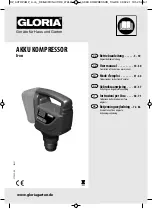
Section 1
3000PB, 3700B, 4500B, 3000PVB, 3700VB, 4500VB User Manual
1: Safety
02250216-786 R01
Subject to EAR, ECCN EAR99 and related export control restrictions.
1
Safety
1.1
General
Sullair and its subsidiaries design and manufacture all of
their products so they can be operated safely. However,
the responsibility for safe operation rests with those who
use and maintain these products. The following safety
precautions are offered as a guide which, if conscien-
tiously followed, will minimize the possibility of accidents
throughout the useful life of this equipment.
The compressor should be operated only by those who
have been trained and delegated to do so, and who have
read and understood this Operator’s Manual. Failure to
follow the instructions, procedures and safety
precautions in this manual may result in accidents and
injuries.
NEVER
start the compressor unless it is safe to
do so.
DO NOT
attempt to operate the compressor with a
known unsafe condition. Tag the compressor and render
it inoperative by disconnecting and locking out all power
at source or otherwise disabling its prime mover so
others who may not know of the unsafe condition cannot
attempt to operate it until the condition is corrected.
Install, use and operate the compressor only in full
compliance with all pertinent OSHA regulations and/or
any applicable Federal, State, and Local codes,
standards and regulations.
DO NOT
modify the
compressor and/or controls in any way except with
written factory approval.
While not specifically applicable to all types of compres-
sors with all types of prime movers, most of the precau-
tionary statements contained herein are applicable to
most compressors and the concepts behind these state-
ments are generally applicable to all compressors.
1.2
Personal protective equipment
A.
Prior to installing or operating the compressor, own-
ers, employers and users should become familiar
with, and comply with, all applicable OSHA regula-
tions and/or any applicable Federal, State and Local
codes, standards, and regulations relative to per-
sonal protective equipment, such as eye and face
protective equipment, respiratory protective equip-
ment, equipment intended to protect the extremities,
protective clothing, protective shields and barriers
and electrical protective equipment, as well as noise
exposure administrative and/or engineering controls
and/or personal hearing protective equipment.
1.3
Pressure release
A.
Install an appropriate flow-limiting valve between the
service air outlet and the shut-off (throttle) valve,
either at the compressor or at any other point along
the air line, when an air hose exceeding ½
″
(13 mm)
inside diameter is to be connected to the shut-off
(throttle) valve, to reduce pressure in case of hose
failure, per OSHA Standard 29 CFR 1926.302(b)(7)
and/or any applicable Federal, State and Local
codes, standards and regulations.
B.
When the hose is to be used to supply a manifold,
install an additional appropriate flow-limiting valve
between the manifold and each air hose exceeding
½
″
(13 mm) inside diameter that is to be connected
to the manifold to reduce pressure in case of hose
failure.
C.
Provide an appropriate flow-limiting valve at the
beginning of each additional 75 feet (23 m) of hose in
runs of air hose exceeding ½
″
(13 mm) inside diame-
ter to reduce pressure in case of hose failure.
D.
Flow-limiting valves are listed by pipe size and flow-
rated. Select appropriate valves accordingly, in
NOTE
Operator is required to read
entire instruction manual.








































